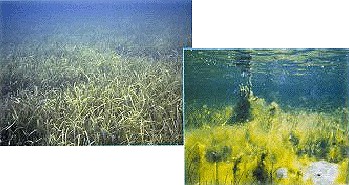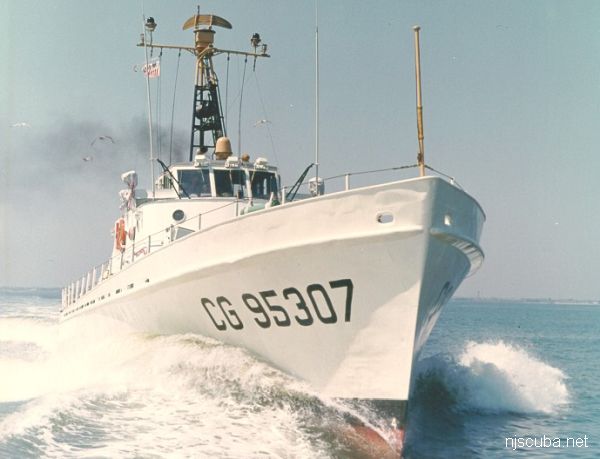Water Pollution (7/7)
Eutrophication

Green Slime is Choking the Life
Out of the State's Bays
Sunday, September 05, 2004
By Alexander Lane
Runoff of Nutrients Fuels Growth of Algae
A wet-suit-clad researcher leapt off a motorboat into Little Egg Harbor one morning last month and set about scouring the bottom for elegant blades of seagrass. He emerged with handfuls of slimy green algae. "The stuff is growing like wildfire, " said Rutgers professor Michael Kennish, supervising the research from onboard the boat. "In a balanced system, it doesn't grow like that." Something is amiss off the Jersey coast.
Eutrophication, a pollution problem that causes runaway algae growth and throws entire ecosystems out of whack, is tightening its grip on New Jersey's long, shallow coastal bays, scientists say. Evidence has been piling up for years. Some 7,500 acres of beneficial underwater plants such as eelgrass disappeared from Barnegat Bay between the mid-1970s and the late 1990s, choked off by algae, according to one study. Another study showed the hard clam population in Little Egg Harbor dropping by 67 percent between 1986 and 2001.
Recently, with pollution ending up in the bay in ever-increasing quantities, scientists have intensified efforts to understand the problem. In April, at a two-day workshop on conditions in Barnegat Bay and Little Egg Harbor, researchers found the system "highly eutrophic, " the worst rating on a scale developed by the National Oceanic and Atmospheric Administration. At least two studies aimed at pinpointing eutrophication's effects are under way: Kennish's federally funded sea-grass inventory, and research on brown tides by visiting Rutgers professor Sybil Seitzinger.
Similar concern is mounting around the world. Among the many bodies of water looking more and more like neglected fish tanks are San Francisco Bay, the Chesapeake Bay, and the Black Sea. The Gulf of Mexico has gotten so bad there's a vast dead zone every year, which left sharks scrambling for food near the Texas coast this summer, according to Nancy Rabalais, a professor at the Louisiana Universities Marine Consortium. Three bathers were bitten.
In New Jersey, as elsewhere, it's getting worse. "It's continuing to escalate, and I don't see it stopping, " said Kent Mountford, a longtime Environmental Protection Agency scientist who wrote a book on Barnegat Bay. "People are not connected to the water around them."
Damaged System
Barnegat Bay, Little Egg Harbor, and Manahawkin Bay form one long estuary, the term for an area where fresh water mixes with saltwater. It stretches 44 miles down the Ocean County coast, washing onto broad beaches and expansive marshes. Narrow spits of sand, Long Beach Island, and a similar barrier island just to the north of it, shelter the estuary from the Atlantic, save for three inlets.
The estuary is one to four miles wide and just a few feet deep in places. But such bodies of water are among the most productive environments on earth, and this one is no exception. More than 100 species of young fish flit among the seagrasses, finding shelter and food as they grow large enough to brave the open ocean. More than 200 other animal species dwell on the bottom, along with 100 plant species. People are also drawn here, to boat, fish, and swim. Tourists spend close to $2 billion a year in Ocean County, supporting some 50,000 jobs, many in and around the estuary.
But the estuary is not what it was. "At one time these systems were teeming with oysters, scallops, and hard clams, " Kennish said, as he cruised across Little Egg Harbor last week. "The oysters are gone, the scallops are basically gone, and the hard clams are declining dramatically."
The major problem is eutrophication -- an overload of nutrients, notably nitrogen, that are crucial in small quantities and deadly in large ones, Kennish said. Nitrogen washes into the estuary off fertilized lawns and farms, pours out of sewage discharge pipes and falls in rain that is laced with power-plant emissions. Then it fuels the runaway growth of certain plants.

Massive algae blooms cloud the water, and sometimes coat the surface with a thick, smelly slime. They blot out the sun, stressing seagrass beds and the creatures that depend on them. Other large algae grows on the bottom, choking the seagrass from below. When the algae dies, it sucks oxygen out of the water.
The vigorous water movement that flushes open water bodies, like Delaware and Raritan bays, is absent from this sheltered, shallow water. "It's like a bathtub, " said Suzanne Bricker, a eutrophication expert with the National Oceanic and Atmospheric Administration. "You put nutrients in and because it doesn't flush well you have ample time for these different kinds of problems to develop."
Some scientists also suspect eutrophication is the culprit behind brown tides, a type of phytoplankton bloom that is harmful to sea life and has become commonplace in the estuary in the past 20 years. Eutrophication may also have caused the rapid rise of the sea nettle, a stinging jellyfish that lives off phytoplankton and has appeared in increasingly large numbers in Barnegat Bay in recent years.
Barnegat Bay has the highest production rate of phytoplankton of 11 similar coastal lagoons around the world. At times as many as 2 million cells of phytoplankton have been found in one milliliter -- which is just a few drops -- of bay water.
The Population Factor
What to do about the problem is far from clear. The state Department of Environmental Protection passed rules in February requiring better management of storm-water runoff by towns and developers. Beyond that, the problem gets trickier, due to a worldwide dependence on nitrogen.
Reactive nitrogen, first produced for gunpowder in the early 1900s, turned out to be a fertilizer so remarkable that people have come to rely on it. Half the quantity ever produced came in the past 15 years, according to an article last year in the journal BioScience. As the environment struggles to find a place for it, it is causing not just coastal eutrophication, but also global warming, ground-level ozone, and smog.
In the Barnegat Bay-Little Egg Harbor Estuary, fertilized lawns are as much a problem as agriculture. Half the nitrogen in the estuary washes in from streams and rivers, 39 percent falls down in rain from the atmosphere -- much of it from power plants in the Midwest -- and 11 percent comes from groundwater, Kennish said.
Some scientists have suggested strategies for minimizing eutrophication, such as bringing back clams and other water-cleaning filter feeders through cultivation, preserving more open space, and restoring stream banks and wetlands. But as long as the population keeps growing, the bay will likely struggle, experts said.
The story is the same around the world. More than half the U.S. and world population resides within 62 miles of the coast, and that number is growing steadily, according to the Institute of Marine Sciences at the University of North Carolina. "The reason we have such a problem with eutrophication in so many of our coastal waters is we have so many people, " Seitzinger said.
Alexander Lane covers the environment. He can be reached at alane@starledger.com or (973) 392-1790.
compiled from various sources

